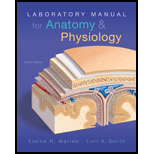
Laboratory Manual for Anatomy & Physiology (6th Edition) (Anatomy and Physiology)
6th Edition
ISBN: 9780134206332
Author: Elaine N. Marieb, Lori A. Smith
Publisher: PEARSON
expand_more
expand_more
format_list_bulleted
Textbook Question
Chapter 14.1, Problem 1CYU
Name the three types of effectors of the autonomic nervous system.
Expert Solution & Answer
Want to see the full answer?
Check out a sample textbook solution
Students have asked these similar questions
Name the neurotransmitter released at each synapse or neuroeffector junction in the somatic and autonomic systems?
Name two defining properties of neurotransmitters.
Name any four neurotransmitters and state some functional differences between them?
Chapter 14 Solutions
Laboratory Manual for Anatomy & Physiology (6th Edition) (Anatomy and Physiology)
Ch. 14.1 - Name the three types of effectors of the autonomic...Ch. 14.1 - Which relays instructions from the CNS to muscles...Ch. 14.1 - MAKING CONNECTIONS The cell bodies of autonomic...Ch. 14.2 - Which branch of the ANS would predominate if you...Ch. 14.3 - In general terms, where are the cell bodies of...Ch. 14.4 - Prob. 6CYUCh. 14.5 - Prob. 7CYUCh. 14.6 - Prob. 8CYUCh. 14.7 - Prob. 9CYUCh. 14.8 - Prob. 10CYU
Ch. 14.9 - Prob. 11CYUCh. 14 - All of the following characterize the ANS except...Ch. 14 - Relate each of the following terms or phrases to...Ch. 14 - The white rami communicates contain what kind of...Ch. 14 - Collateral sympathetic ganglia are involved with...Ch. 14 - Briefly explain why the following terms are...Ch. 14 - Describe the anatomical relationship of the white...Ch. 14 - Prob. 7SAQCh. 14 - Which of the effects listed in response to...Ch. 14 - Which ANS fibers release acetylcholine? Which...Ch. 14 - Describe the meaning and importance of sympathetic...Ch. 14 - Prob. 11SAQCh. 14 - Describe the importance of the hypothalamus in...Ch. 14 - Postganglionic neurons are also called ganglionic...Ch. 14 - 10-Year-Old Boy with Spinal Injury On arrival at...Ch. 14 - 10-Year-Old Boy with Spinal Injury On arrival at...Ch. 14 - 10-Year-Old Boy with Spinal Injury On arrival at...Ch. 14 - Prob. 4CCSCh. 14 - 10-Year-Old Boy with Spinal Injury On arrival at...Ch. 14 - Prob. 6CCSCh. 14 - 10-Year-Old Boy with Spinal Injury On arrival at...Ch. 14 - Prob. 8CCS
Knowledge Booster
Learn more about
Need a deep-dive on the concept behind this application? Look no further. Learn more about this topic, biology and related others by exploring similar questions and additional content below.Similar questions
- Draw a graph of the autonomic system and identify the neurotransmitters and receptors such as dopamine,norephinephrine and etc. and where it binds to alpha and beta. please explain as well.arrow_forwardName the neurotransmitter released at each synapse orneuroeffector junction in the somatic and autonomic system?arrow_forwardA) Explain what dual innervation means with regard to the autonomic nervous system. B) Using the cardiovascular, respiratory and digestive systems as examples, explain how dual innervation regulates the function of each system.arrow_forward
- Match the following statements to the correct neurotransmitter of the autonomic nervous system. Select "Both" if the statement is true of both neurotransmitters. Secreted by cholinergic fibers. Receptors for this neurotransmitter may cause either excitatory or inhibitory responses. Bind(s) to adrenergic receptors. Receptors for this neurotransmitter are found on all autonomic postganglionic neurons. This neurotransmitter can increase heart rate. ANSWER OPTIONS: Acetylcholine or Norepinephrine? Both?arrow_forwardWhy is a single autonomic neurotransmitter able to have opposite effects on different target cells?arrow_forwardDescribe the actions of THREE different neurotransmitters..arrow_forward
- Nervous system functions that directly employ acetylcholine neurotransmitters are referred to as cholinergic. Drugs that might be therapeutic in treating the symptoms of dopamine loss in Parkinson’s disease could include multiple choice 1 dopaminergic agonists and cholinergic antagonists. dopaminergic antagonists and cholinergic antagonists. dopaminergic antagonists and cholinergic agonists. dopaminergic agonists and cholinergic agonists. 2. From the information provided, drugs used to treat Parkinson’s disease symptoms will act at which location? multiple choice 2 The globus pallidus The substantia nigra The striatum 3. Which of the following might be therapeutic in the treatment of Parkinson’s disease symptoms? multiple choice 3 all of these choices listed may be therapeutic increasing dopamine receptor responsiveness monoamine oxidase inhibition increasing dopamine release decreasing dopamine…arrow_forwardA patient has been exposed to the organophosphate pesticide malathion,which inactivates acetylcholinesterase. Which of the following symptoms would you predict: blurring of vision, excess tear formation, frequent or involuntary urination, pallor (pale skin), muscle twitching, orcramps? Would atropine be an effective drug to treat the symptoms?(See Clinical Impact 16.2 for the action of atropine.) Explain.arrow_forwardGive two mechanisms by which neurotransmitters exert their effects.arrow_forward
- Name the types of autonomic synapse in terms of neurotransmitter used; are they excitoratory, inhibitory, or can be both? (such as Adrenergic, Muscarinic, and Nicotinic)arrow_forwardGive FOUR criteria for identifying a substance as a neurotransmitter.arrow_forwardIn the sympathetic division of the autonomic nervous system: Select one: The ratio between the number of postganglionic and preganglionic neurons is small. A single preganglionic neuron usually synapses with a single postganglionic neuron. An important functional characteristic is convergence of the preganglionic fibers. Preganglionic fibers are usually much longer than the postganglionic fibers. Activity of the neurons tends to have a more generalized and widespread effect on the body.arrow_forward
arrow_back_ios
SEE MORE QUESTIONS
arrow_forward_ios
Recommended textbooks for you
 Human Physiology: From Cells to Systems (MindTap ...BiologyISBN:9781285866932Author:Lauralee SherwoodPublisher:Cengage Learning
Human Physiology: From Cells to Systems (MindTap ...BiologyISBN:9781285866932Author:Lauralee SherwoodPublisher:Cengage Learning

Human Physiology: From Cells to Systems (MindTap ...
Biology
ISBN:9781285866932
Author:Lauralee Sherwood
Publisher:Cengage Learning
Nervous System - Get to know our nervous system a bit closer, how does it works? | Neurology; Author: FreeMedEducation;https://www.youtube.com/watch?v=6O-0CVAgaEM;License: Standard youtube license